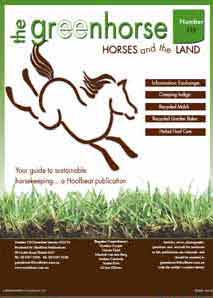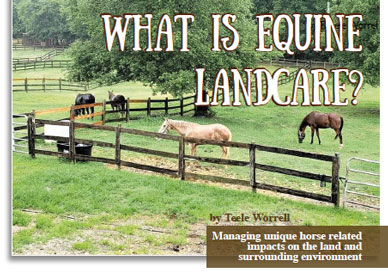The Green Horse section provides practical information on managing environmentally sustainable horse properties, readers stories and tips, as well as advice and articles from equestrian experts in their fields.
October/November '22
Vol 44 No 3
In this issue of The Green Horse you will find the following articles
What is Equine Landcare?
Part 1 of a series
by Teele Worrell
Solar Lights on the Equine Property-Part 2
by Celine Bønnelykke
Spray - Grazing
by Rhiannon Brown – Envirapest
SPRING PASTURES -
by Belinda Taylor
Why can horses happily graze pasture through Winter but have issues in Spring. by Belinda Taylor
Getting Ready for a Wet Summer by Country Park
WIN A YEAR'S SUBSCRIPTION...
share your equine property management tips and each issue one reader will win.
Send ideas to -
The Green Horse Support <enquiries@hoofbeats.com.au>


PREVIOUS ARTICLES
Available on line
August/September 22
THE IMPORTANCE OF GROUND COVER
by Belinda Taylor
Ground cover, whether it be dead grass, weeds, hay, or mulch is the insulating layer that protects your soil from the extremes of temperature and erosion.
June/July 22
SOLAR FOR YOUR ARENA
Environmentally-friendly solar lighting for your arena will allow you to use your arena for longer, and as energy from the sun is free it is therefore an ideal long-term solution for powering lights. Jeff Florence from Blackfrog Solar, Queensland suggsted some solar tips.
April/May 22
MAKING THE MOST OF MOSQUITO CONTROL
by Rhiannon Brown - Envirapest
Climate change that has brought high temperatures, more rain and increases in humidity will provide ideal breeding grounds for the many species of mosquitoes, including those that spread the Japanese Encephalitis virus (JEV).February/March 2022
February/March 22
SUSTAINABLE DEWORMING
by Sophie Fletcher
There has been a relatively big shift in deworming treatment strategies in recent years, due to increasing levels of worm resistance to the chemicals we have been using for decades to control them, resulting in a lot of confusion among horse owners.
December/January 21/22
ARE YOU PREPARED FOR THE FIRE SEASON
In the many areas where horse owners live this season's fire preparation should be well underway; if you’ve not already started preparing your property for summer then now is the time to do so.
October/November21
SNAKE UNIVERSAL ANTIVENOM
The good news is that there is no longer any need for a snake to be identified to administer antivenom. A universal antivenom is now used that covers the five genus of snake that will cause serious harm or death.
August/September 21
BEAT THE BINDI
by Rhiannon Brown - Envirapest
The prickly weeds that grow on our properties across Australia usually have long classical Latin names, are often known by a variety of common names in different localities but are regularly called very rude names when we happen to stand on one (or a dozen) or when they find our hands as we are dislodging tangles in the horse’s mane or tail.
June July 21
BARN OWLS by Wendy Elks
A silent partner in rodent control.
Non-toxic pest management is the most humane and ecologically sustainable way of bringing nature back into some kind of balance during non-plague times.
April/May 21
LOVELY LAWNS
by Rhiannon Brown - Envirapest
On a horse property there always seems to be hectares of grass, but we all have that little bit of lawn we want to look luscious all year round.
It could be the entrance to the stables, laneways bordering the driveway, that little ‘special’ snack paddock or you could even dream of a beautiful green arena. So, how do we achieve this?
Feb/March 21
STABLE DANGERS
by Elizabeth Tollarzo
They say that horses are accidents-waiting-to-happen as they are inclined to find every conceivable way to injur themselves, usually just before a competition. Being aware of potential dangers in the stable - and addressing these - may help aleiviate injury.
Dec/Jan 20/21
HORSES AND HONEY BEES-
Can they share space on the property?
by Wendy Elks
Oct/Nov 20
SOLAR-POWERED PRODUCTS
by Celine Bønnelykke
In previous issues we have discussed the economics of setting up a solar-driven property, but if finances don’t stretch to installation of the whole package, there are ways to ease into the solar-world.
Aug/Sept 20 THE HIDDEN DANGERS IN OUR PADDOCK.
by Elizabeth Tollarzo
Horses love to run, play, buck and then run again and we often, through lack of risk assessment or management practices, place them in areas that are fraught with dangers.
JUNE JULY 20 GOING SOLAR ON THE HORSE PROPERTY Where to put your panels Part 2
Once you have selected what solar system best suits your needs, then you need to look at how you can maximise the advantages.
APRIL MAY 20 GOING SOLAR ON THE HORSE PROPERTY Part 2
Once you have selected what solar system best suits your needs, then you need to look at how you can maximise the advantages.
FEB/MARCH 20 ANTS AWAY
by Mark Brown Envirapest
So, what can you do to deter ants from your house and your stables??
DJ19/20 KEEPING SNAKES OUT OF THE STABLE by Wendy Elks
Snakes may be protected under Wildlife regulations in Australia, and they may be great for keeping the mice and rats down, but do we want to find them in our stables near our horses and pets?
ON19 - TERMITES- common myths
by Rhiannon Brown, Envirapest
Your house and stables are looking wonderful this spring, but do you know what is happening inside the walls of your brick or timber building?
AS19 - OUCH THAT HURTS
by Catherine Bird for Country Park Saddlery
The extent of the swelling is usually an indication of the severity of the infection or injury and the cause needs to be established before giving herbs.
JJ19 - MANAGING PASTURE
by Rhiannon Brown, Envirapest Healthy pasture means healthy horses.
A/M19 - STOP THOSE WEEDS
Property biosecurity
by Rhiannon Brown, Envirapest
Putting simple precautionary steps into place can make it tough for weeds to get a hold on your equine paradise.
|
  
  


As a landcare officer Teele Worrell spent years delivering events for horse owners, educating them on sustainable land management techniques tailored to the challenges of owning horses.
One presentation, appropriately titled ‘Protecting your land from the ones you love’, went through five important themes of equine landcare. Property owners could work their way through the themes to integrate sustainable land management practises onto their properties.
In this series of articles Teele will explore what equine landcare is, and why it benefits equine landholders. Following articles will focus on the themes of property planning, soil, weeds, pasture establishment and pasture management, all topics that have been touched on before but are such an important aspect of property ownership.
So, what is Equine Landcare?
Horse owners face unique challenges when managing their land. Horses have a selective grazing technique; are heavy with their weight distributed on four small points, and are generally kept on smaller properties in a peri-urban environment.
There are many benefits to improving the health of the land your horses reside on. The problem is horses often work against, not with you! Despite this, improving your land will in turn improve the health of your horse as well as the wider natural landscape and your wallet.
Yes, improving the health of your land can lead to fewer vet bills.
For instance, reducing soil erosion can prevent illnesses linked to dust irritation or colic from picking up sand.
Planning your property to encourage horse movement and increase herd interactions can reduce injuries caused by high jinks, improve muscle tone and a horse’s mental health.
Building a diverse and healthy pasture provides a wider range of nutrients to a horse’s diet leading to all round health benefits.
It is not just your horse that benefits from a healthier plot of land. Good land management can prevent soil erosion, reducing pollution into local waterways and protect natural environments. For example, fencing off native trees and replanting native understorey can provide a wind-break and shelter for your horses, anchor your soil and provide crucial habitat to local wildlife.
Your bank balance can also be protected through good land management. While reducing vet bills will certainly help with this, improving the health of your land can also reduce feed and water bills as well as increasing the value of your land long-term. While integrating sustainable land management practises onto your horse property may require an initial investment, it will pay dividends in the long run.
Improving the health of your land can also increase your own satisfaction and mental wellbeing. When your property looks healthy all year round the feeling is priceless!
The biggest piece of advice is to break down long-term visions into short-term plans. Improving the health of your land does take time, effort, and money. Some, or let’s face it all, of these things may be in short supply if you own horses.
For example, you may have purchased a property and started using it in the same way the previous owner had done. Changing fence lines, setting up sacrificial areas or modifying the irrigation could feel like impossible tasks. One step at a time can make your long-term vision more manageable and a few years in - without breaking your sanity, back or bank account -you can find yourself reaping the rewards.
 |